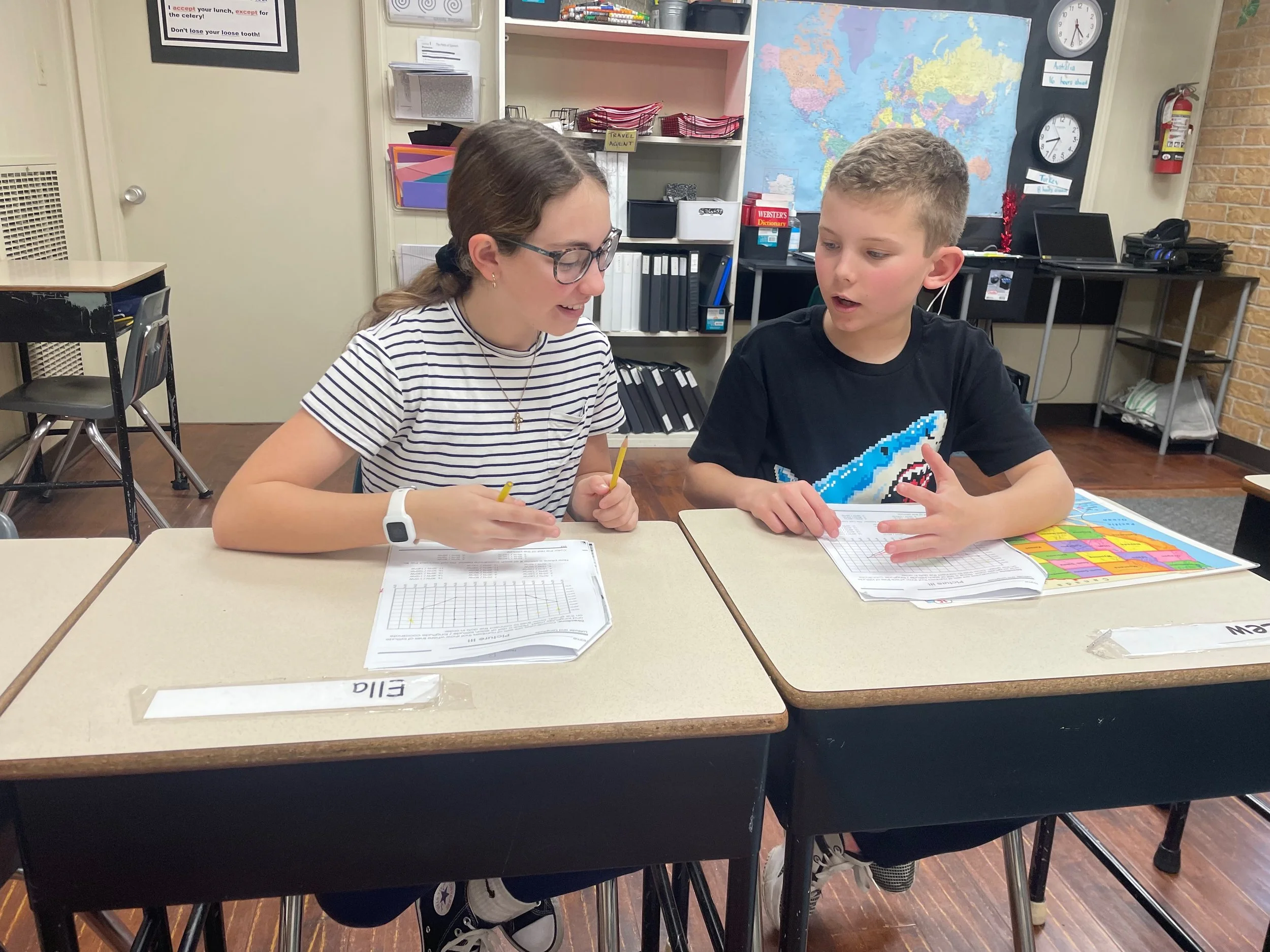Collaboration
Collaboration is another method we use to teach life lessons through purposeful education. Learning how to work with others is something every adult needs to know. No one operates completely alone. Teaching children how to collaborate at this level gives them the skills they can build on in middle school, high school, and beyond.
We believe that individual self-awareness allows students to embrace the gifts of others.
We encourage students to become independent and self-reliant, which empowers them to contribute to our community.
At our core…
Empowering Learners: A Collaborative Approach to Education
Our classrooms are abuzz with curiosity and collaboration. We believe in fostering student agency, where inquiry drives the learning process. Students are not passive recipients of information; they are active explorers with voice and choice.
Through authentic investigations, students take total responsibility for their learning. They engage in meaningful interactions and discussions, delving into purposeful projects that span across disciplines, from language arts and science to social studies. This cross-curricular approach offers something for everyone, igniting the spark of curiosity even in the most reluctant learners.
Imagine this: students are no longer confined to standardized tests. Instead, they demonstrate their understanding through performance-based assessments. This shift empowers them to create knowledge, not simply regurgitate facts. As a facilitator, the teacher acts as a coach, guiding and supporting students on their learning journey.
By embracing inquiry-based learning, we empower students to become strategic thinkers and collaborative problem-solvers. They develop a deeper understanding of themselves and the world around them, all while fostering a love of learning that extends far beyond the classroom walls.
Collaboration: Building the Skills for Life
In our classrooms, collaboration isn't just a teaching method, it's a cornerstone of purposeful education. We recognize that the ability to work effectively with others is an essential life skill. No matter the career path, individuals rarely operate in complete isolation.
By fostering collaboration at a young age, we equip our students with the building blocks for success. They learn to communicate openly, share ideas constructively, and navigate diverse perspectives. These skills become invaluable assets as they progress through middle and high school, and ultimately, throughout their lives.
Through collaborative learning, our students not only gain academic knowledge but also develop critical social and emotional skills that empower them to become confident, adaptable, and successful members of society.
Fostering Emotional Intelligence Through Collaborative Learning
Gone are the days of passive lectures! In our classrooms, we embrace a dynamic approach that empowers students to develop emotional intelligence. Instead of a teacher simply imparting knowledge, we spark curiosity and collaboration.
Imagine this: the question posed is "What are healthy ways to manage anger?" Students then form groups, becoming co-explorers on a journey of discovery. Jacob shares his calming techniques, while Jessica describes what feeling calm means to her. Each voice contributes a unique perspective, enriching the collective understanding.
Through these group discussions, students unlock a treasure trove of diverse strategies. They learn from each other's experiences, fostering empathy and understanding. This collaborative process not only equips them with a wider range of coping mechanisms but also builds their confidence in their ability to problem-solve.
The culmination of this exploration is a group presentation. Students, now experts on their chosen calming techniques, confidently share their knowledge with the class. This empowers them to not only learn but also teach, solidifying their understanding and boosting their self-esteem.
Our approach acknowledges that there's no one-size-fits-all solution for managing emotions. By fostering collaboration and open communication, we equip students with the tools and confidence to navigate their emotional landscape effectively, building valuable emotional intelligence along the way.
Learning Through Movement and Collaboration
Gone are the days of static learning! We believe in engaging young minds through movement and collaboration, a far cry from the traditional "sit-and-listen" approach. Instead of forcing students to remain stationary all day, we encourage frequent movement throughout the learning process. This might involve physically acting out problems like math equations. Imagine a group tackling the question: "A zookeeper feeds 7 fish each to 2 hippos and 4 fish each to 2 alligators. How many fish were eaten at the zoo?" Through collaboration, the students decide who acts as the zookeeper, who represents the hippos, and so on. By actively participating and moving around, they not only solve the problem (22 fish!), but they also have a fun and engaging learning experience, far more memorable than the traditional method of a teacher simply writing on the board. This approach fosters a love of learning, encourages critical thinking, and builds essential social skills like teamwork and communication. We believe that learning should be dynamic, interactive, and enjoyable, paving the way for a lifelong love of exploring and understanding the world around us.
Empowering Learners: Student-Driven Decisions
Our classrooms embrace a unique approach to learning student-driven decision making. Throughout the day, teachers facilitate meaningful choices for the class. Whether it's deciding to take the lesson outdoors for a change of scenery or prioritizing reading over writing, students collectively shape their learning journey.
This is not simply about preference; it's about purposeful education. By having a voice in the classroom, students gain confidence and learn to respect diverse perspectives. They actively listen to their peers, like Katie, and understand that learning can be a collaborative experience, fostering empathy and understanding. Today, they might choose to follow Katie's suggestion, but they know their turn to lead will come.
This approach fosters a sense of ownership over their education. Students become actively engaged participants, not passive recipients of information. They learn to advocate for themselves, communicate effectively, and navigate different viewpoints, preparing them for success in a complex and ever-changing world.
